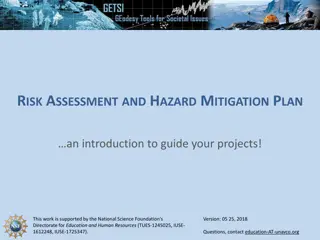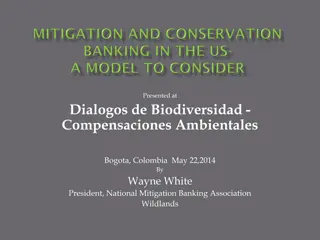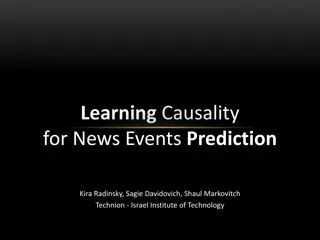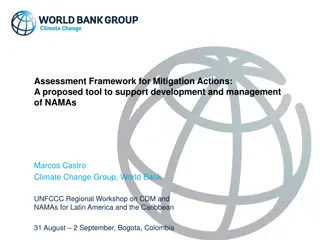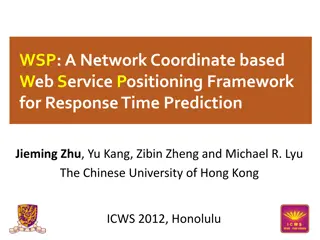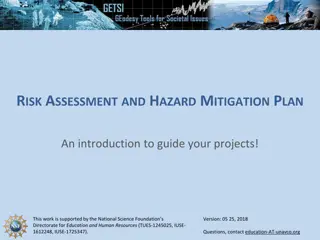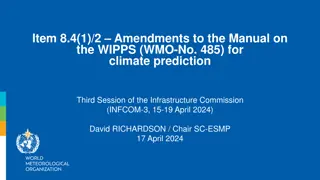Understanding Impact Prediction, Evaluation, and Mitigation
Impact prediction involves identifying the magnitude and significance of environmental changes due to a project or action. It is crucial to assess both direct and indirect effects on various aspects such as human beings, flora, fauna, geology, land, water, air, and climate. Evaluating these effects helps in understanding the potential consequences and implementing suitable mitigation strategies to minimize negative impacts.
Download Presentation

Please find below an Image/Link to download the presentation.
The content on the website is provided AS IS for your information and personal use only. It may not be sold, licensed, or shared on other websites without obtaining consent from the author. Download presentation by click this link. If you encounter any issues during the download, it is possible that the publisher has removed the file from their server.
E N D
Presentation Transcript
Impact prediction, evaluation and mitigation
1. Prediction 1.1. Dimensions of prediction (what to predict) The object of prediction is to identify the magnitude and other dimensions of identified change in the environment with a project or action An important distinction is often made between the prediction of the likely magnitude (i.e. size) and the significance (i.e. the importance for decision-making) of the impacts. Magnitude does not always equate with significance. For example, a large increase in one pollutant may still result in an outcome within generally accepted standards, whereas a small increase in another may take it above the applicable standards in a sensitive environment .
Assessment of effects (including direct and indirect, secondary, cumulative, short-, medium-and long-term, permanent and temporary, positive and negative effects of project) Effects on human beings, buildings and man-made features 1 Change in population arising from the development, and consequential environment effects. 2. Visual effects of the development on the surrounding area and landscape. 3. Levels and effects of emissions from the development during normal operation. 4. Levels and effects of noise from the development. 5. Effects of the development on local roads and transport. 6. Effects of the development on buildings, the architectural and historic heritage, archaeological features, e.g. through pollutants, visual intrusion, vibration.
Effects on flora, fauna and geology 7. Loss of, and damage to, habitats and plant and animal species. 8. Loss of, and damage to geological features. 9. Other ecological consequences. Effects on land 10. Physical effects of the development, e.g. change in local topography, soil erosion, etc. 11. Effects of chemical emissions and deposits on soil of site and surrounding land.
12. Land-use/resource effects: (a) quality and quantity of agricultural land to be taken. (b) other alternative uses of the site. (c) effect on surrounding land uses including agriculture. (d) waste disposal. Effects on water 13. Effects of development on drainage pattern in the area. 14. Changes to other hydrographic characteristics, e.g. groundwater level, watercourses, flow of underground water. 15. Effects of pollutants, waste, etc. on water quality.
Effects on air and climate 17. Level and concentration of chemical emissions and their environmental effects. 18. Particulate matter. 19. Offensive odors. 20. Any other climatic effects.
Other indirect and secondary effects associated with the project 21. Effects from traffic (road, rail, air, water) related to the development. 22. Effects arising from the extraction and consumption of material, water, energy or other, resources by the development. 23. Effects of other development associated with the project, e.g. new roads, sewers, housing power lines, pipelines, telecommunications, etc. 24. Effects of association of the development with other existing or proposed development. 25. Secondary effects resulting from the interaction of separate direct effects listed above.
1.2. Methods for prediction (how to predict) There are many possible methods to predict impacts 1.2.1 Mathematical and computer-based models Mathematical models represent the behavior of aspects of the environment through the use of mathematical functions. They are usually based upon scientific laws, statistical analysis or some combination of the two. The functions of these models can range from simple direct input-output relationships to more complex dynamic mathematical models.
There are many mathematical models available for particular applications. For instance, a pollution-monitoring study to describe the concentration of a pollutant as a function of the stream-flow rates and the distance downstream. They can compare conditions at a contaminated site and a control site to determine the significance of any differences in monitoring data. They can extrapolate a model to conditions outside the data range used to derive the model e.g. from toxicity at high doses of a pollutant to toxicity at low doses or from data that are available to data that are unavailable e.g. from toxicity in rats to toxicity in humans.
1.2.2 Architectural models and experimental methods Architectural models are illustrative some element of the project-environment interaction. For example, a scale model (or computer graphics) could be used to predict the impacts of a development on the landscape or built environment. Recent software can be used to show the views of the project site from the receptor areas. Field and laboratory experimental methods use existing data, often supplemented by special surveys, to predict impacts on receptors. Laboratory tests are usually cheaper to run but may not extrapolate well to conditions in natural systems.
1.2.3 Expert judgments It includes development comparing the environmental conditions at one site with those at similar sites elsewhere, comparing an unknown environmental impact (e.g. of wind turbines on radio reception)with a known environmental impact (e.g. of other forms of development on radio reception). Analogue models can be developed from monitoring of similar projects. comparing with the similar impacts existing of proposed development, a a
1.3. Choice of prediction methods The nature and choice of prediction methods vary according to the impacts under consideration. Projects with hard impacts: mathematical simulation models play a central role. These include, for example, air and noise impacts. Air pollution impact prediction has been dominated by approaches which simulates the shape of the pollution plume from the development under concern. Projects with soft impacts: the use of mathematical simulation is not available. For example, ecology and landscape. Ecology depends very much on field sample survey for plant and animal species, where the expert s opinion of what requires sampling plays an important role. Projects with mixed impacts: impact prediction where simulation modeling is complemented (and sometimes replaced) by more technically lower-level approaches. Traffic impacts make considerable use of modelling, but often with some sample survey input






